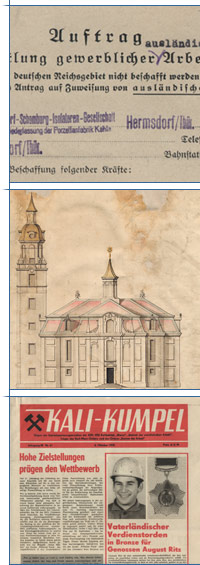Description
The district archives existing in Thuringia date back to the centralisation and nationalisation of the GDR archives and the associated legislation. The "Order to Establish City and District Archives" of 26 February 1951 obliged the city and district districts to establish archives. As a result, the establishment of district archives began in the then existing districts of Thuringia. The responsibility of the new district archives should extend to archival material grown from their own administration and to archiving for municipalities without their own archives. Furthermore, the district archives should build up management archives (intermediate archives).
At that time there were 21 counties in the state of Thuringia. As early as 1952, the GDR's states and self-governing districts fell victim to centralisation. Instead of the countries 14 districts were formed. A new district structure was fitted into the district borders, although the national borders were partly ignored. In Thuringia, the districts of Erfurt, Gera, Suhl and 32 new districts were created. In each of these districts a district archive was established or the one existing since 1951 was continued. The tasks laid down in the 1951 order remained and were usually tackled by only one personnel department, the archives clerk. The establishment and maintenance of an administrative archive was later added as the number of registries grew. In the 1950s and 1960s, the municipal holdings were transferred to the district archives on a nationwide basis until 1945. In later takeover actions, most of the district archives succeeded in supplementing the holdings of the municipalities beyond 1945. However, the activities of the employees were often influenced by poor technical equipment and lack of space. The state of processing after integration into the district archives presented itself very differently. For the most part, the community archives were simply listed on index cards. However, many stocks also remained unprocessed. Inventory overviews were not created. An exception was the Meiningen District Archive, which published a printed inventory overview in 1971.
In 1965, the responsibilities of the archives in the GDR were newly regulated. According to this, the district archives were responsible for the transmission of the councils of the districts from 1952 and the companies and institutions subordinate to them, as well as for the municipal archives. The tradition of the districts before 1952 went to the state archives. As a result, the holdings of the districts existing in Thuringia before 1945 are now located in the regional state archives as well as the holdings of the districts from 1945-1952 (county councils of the districts). In 1976 the responsibility of the district archives was extended to the archives of cooperatives as well as to the towns belonging to the district without a confirmed final archive.
After 1990, the districts were reconstituted on the basis of local legislation. Initially there was great legal uncertainty about the question of the continued existence of the district archives and the further preservation of the community archives. This could only be eliminated by the Thuringian Archives Act of 23 April 1992. In § 4 it was stipulated that municipalities archive their archival material on their own responsibility. Since then, many smaller towns and communities have been archiving on their own responsibility. However, the majority left their archival holdings in the district archives and made corresponding contractual arrangements with the districts. The district archives were now faced with a variety of new tasks. The documents of legal and functional predecessors had to be taken over, administrative archives had to be dissolved, new holdings had to be created, new legislation had to be drawn up and, last but not least, technical modernisations had to be carried out and extension buildings had to be planned. Another challenge was the ![]() Area Reform of 1994. As a result, the number of districts was reduced from 35 to 17. Today there are district archives in all 17 districts, partly with branch offices in the old district towns.
Area Reform of 1994. As a result, the number of districts was reduced from 35 to 17. Today there are district archives in all 17 districts, partly with branch offices in the old district towns.
